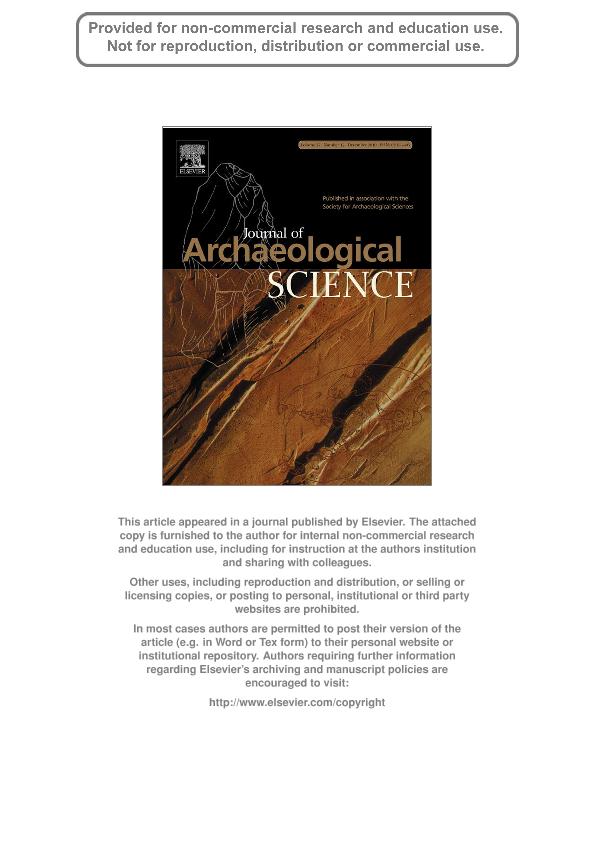Mostrar el registro sencillo del ítem
dc.contributor.author
Bonomo, Nestor Eduardo

dc.contributor.author
Osella, Ana Maria

dc.contributor.author
Ratto, Norma Rosa

dc.date.available
2018-09-21T13:31:57Z
dc.date.issued
2010-04
dc.identifier.citation
Bonomo, Nestor Eduardo; Osella, Ana Maria; Ratto, Norma Rosa; Detecting and mapping buried buildings with Ground-Penetrating Radar at an ancient village in northwestern Argentina; Academic Press Ltd - Elsevier Science Ltd; Journal of Archaeological Science; 37; 12; 4-2010; 3247-3255
dc.identifier.issn
0305-4403
dc.identifier.uri
http://hdl.handle.net/11336/60553
dc.description.abstract
We describe an archaeo-geophysical investigation performed near the Palo Blanco archaeological site, Catamarca, Argentina. A large area beyond the northern limit of the site was explored with the Ground-Penetrating Radar (GPR) method in order to detect new buildings. The exploration showed signals of mud-walls in a sector that was located relatively far from the previously known buildings. A detailed survey was performed in this sector, and the results showed that the walls belonged to a large dwelling with several rooms. The discovery of this dwelling has considerably extended the size of the site, showing that the dwellings occupied at least twice the originally assumed area. High-density GPR surveys were acquired at different parts of the discovered building in order to resolve complex structures. Interpreted maps of the building were obtained. Different characteristics of the walls were satisfactory determined, in spite of the low contrast of the dielectric constant at their interfaces and the noticeable spatial fluctuations of the signals due to wall collapses.Systematic excavations confirmed the GPR maps providing further relevant information about the characteristics of the walls and the occupational floor, as well as material for radiocarbon analyses. These analyses indicated that the discovered building was occupied until about AD 880. This fact extends 180 years the previously known period for the village, and also for the settlements in the region (formerly, AD 200 to AD 700). The performed investigations moreover confirmed different architectural characteristics assumed for Palo Blanco, related to the internal and external layouts. Interconnection between the rooms without intermediary courtyards seems to indicate a better use of the internal spaces and a more integrated spatial conception in Palo Blanco than in other villages of the region. © 2010 Elsevier Ltd.
dc.format
application/pdf
dc.language.iso
eng
dc.publisher
Academic Press Ltd - Elsevier Science Ltd

dc.rights
info:eu-repo/semantics/openAccess
dc.rights.uri
https://creativecommons.org/licenses/by-nc-sa/2.5/ar/
dc.subject
Formative Period in Nw-Argentina
dc.subject
Gpr Survey
dc.subject
Tapia Wall Signals
dc.subject.classification
Historia

dc.subject.classification
Historia y Arqueología

dc.subject.classification
HUMANIDADES

dc.title
Detecting and mapping buried buildings with Ground-Penetrating Radar at an ancient village in northwestern Argentina
dc.type
info:eu-repo/semantics/article
dc.type
info:ar-repo/semantics/artículo
dc.type
info:eu-repo/semantics/publishedVersion
dc.date.updated
2018-09-10T16:34:28Z
dc.journal.volume
37
dc.journal.number
12
dc.journal.pagination
3247-3255
dc.journal.pais
Países Bajos

dc.journal.ciudad
Amsterdam
dc.description.fil
Fil: Bonomo, Nestor Eduardo. Universidad de Buenos Aires; Argentina. Consejo Nacional de Investigaciones Científicas y Técnicas; Argentina. Consejo Nacional de Investigaciones Científicas y Técnicas. Oficina de Coordinación Administrativa Ciudad Universitaria. Instituto de Física de Buenos Aires. Universidad de Buenos Aires. Facultad de Ciencias Exactas y Naturales. Instituto de Física de Buenos Aires; Argentina
dc.description.fil
Fil: Osella, Ana Maria. Universidad de Buenos Aires; Argentina. Consejo Nacional de Investigaciones Científicas y Técnicas; Argentina. Consejo Nacional de Investigaciones Científicas y Técnicas. Oficina de Coordinación Administrativa Ciudad Universitaria. Instituto de Física de Buenos Aires. Universidad de Buenos Aires. Facultad de Ciencias Exactas y Naturales. Instituto de Física de Buenos Aires; Argentina
dc.description.fil
Fil: Ratto, Norma Rosa. Universidad de Buenos Aires; Argentina. Consejo Nacional de Investigaciones Científicas y Técnicas. Oficina de Coordinación Administrativa Ciudad Universitaria. Instituto de Física de Buenos Aires. Universidad de Buenos Aires. Facultad de Ciencias Exactas y Naturales. Instituto de Física de Buenos Aires; Argentina
dc.journal.title
Journal of Archaeological Science

dc.relation.alternativeid
info:eu-repo/semantics/altIdentifier/url/http://www.journals.elsevier.com/journal-of-archaeological-science/#description
dc.relation.alternativeid
info:eu-repo/semantics/altIdentifier/doi/http://dx.doi.org/10.1016/j.jas.2010.07.025
Archivos asociados
